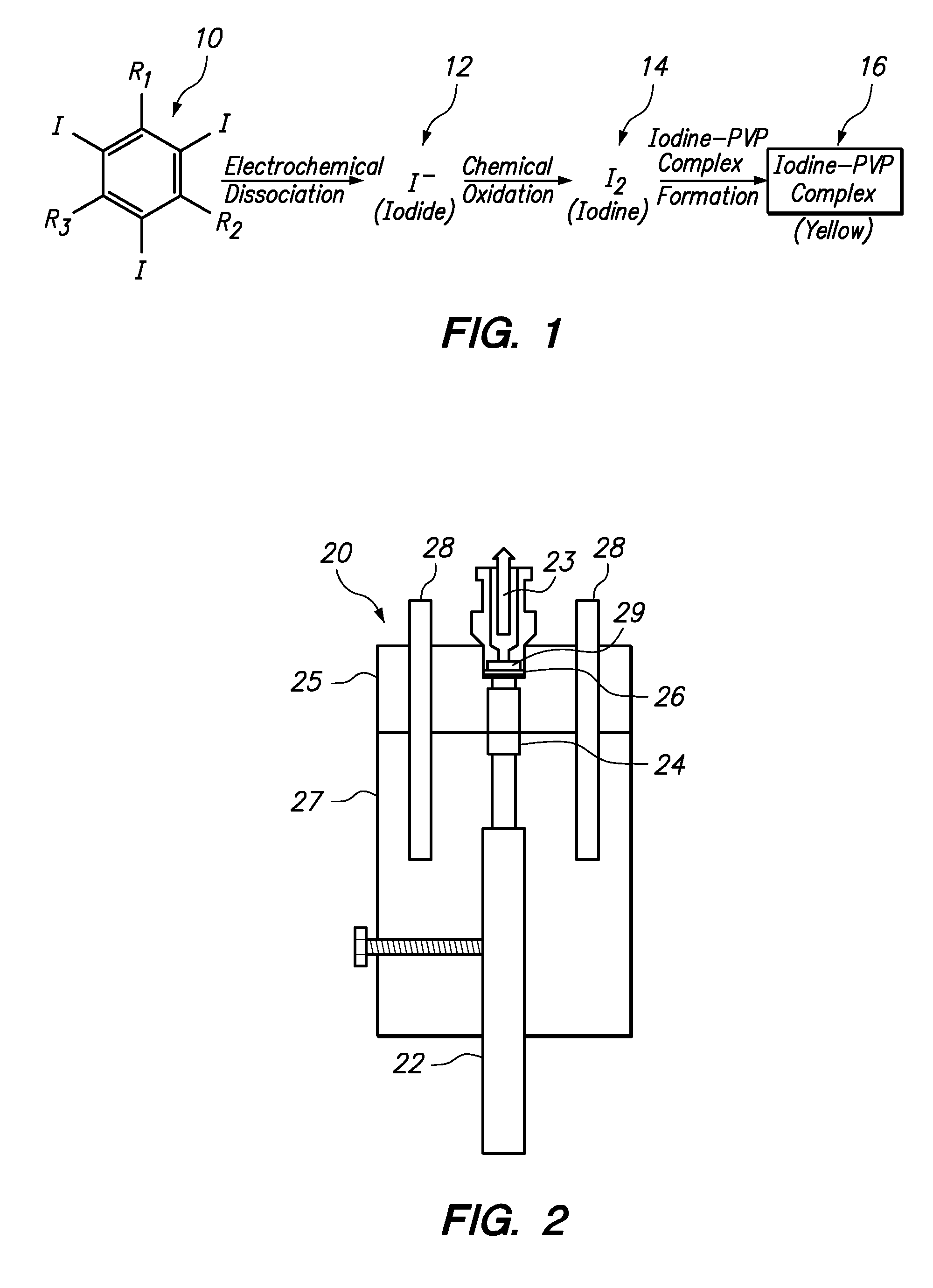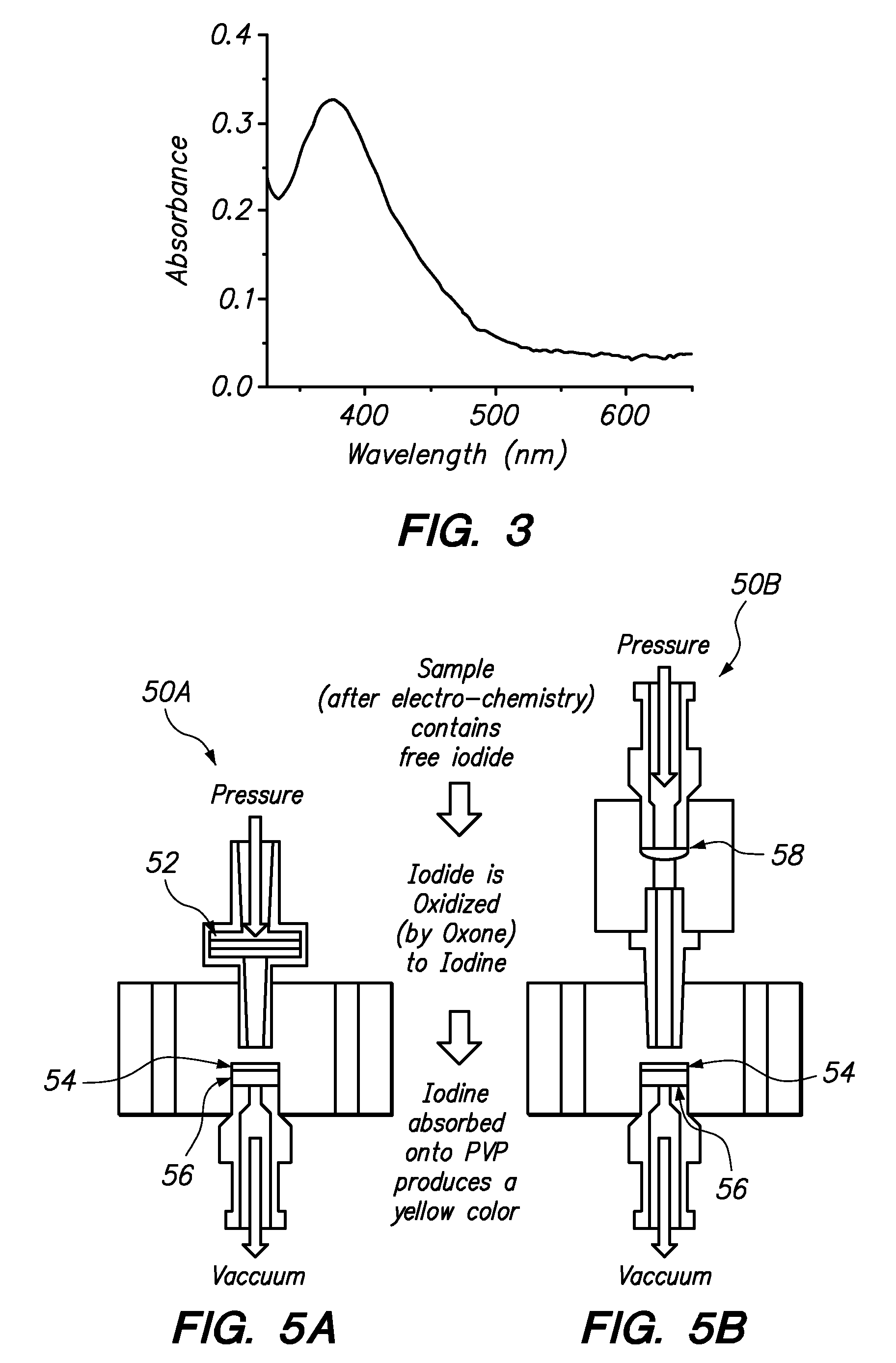Apparatus and method for determining the concentration of iodine-containing organic compounds in an aqueous solution
a technology aqueous solutions, which is applied in the field of apparatus and methods for measuring the concentration of iodine-containing organic compounds in an aqueous solution, can solve the problems of inconvenient protocol for measuring inulin clearance, errors in estimating the level of gfr from the serum creatinine concentration, and major medical problems of ckd, etc., to achieve good adherence of pvp and facilitate refl
- Summary
- Abstract
- Description
- Claims
- Application Information
AI Technical Summary
Benefits of technology
Problems solved by technology
Method used
Image
Examples
example 1
Preparation of Oxidation Filters and Chemical Oxidation of Iodide to Iodine
[0052]A first oxidation and PVP exposure system 50A was assembled as shown in FIG. 5A. The system included a PTFE filter 52 having a 0.45 mm pore size and a diameter of 13 mm for supporting dried Oxone, a second filter 54 coated with polyvinyl pyrrolidone (PVP), and a porous frit 56 (10 μm UHMWPE, diameter 0.188 inches, thickness 0.062 inches). 40 μL of 2 mg / mL of aqueous Oxone solution was placed into the 13 mm hydrophilic PTFE syringe filter 52 and the iodide-containing sample was flowed through it. It was found that allowing the Oxone to dry for a period of several hours increased the capacity to oxidize iodide in a subsequent sample. It is believed that the dried Oxone takes some time to re-dissolve, and thus remains a bit longer in the syringe filter and becomes available to a larger fraction of the aqueous iodide sample flowing through the syringe filter.
[0053]In a similar run using the system 50B shown...
example 2
Electrolysis Parameters
[0055]Referring to FIG. 7, a three electrode system cell 60 with a potentiostat from CH Instruments Model 730A (not shown) was used for the optimization of the electrochemical cell and the parameters for the electrolysis of Iothalamate in pH 7.4 phosphate buffer saline 0.1M in phosphate with 0.15 M NaCl (PBS). An in-house fabricated bismuth electrode 62 (as described above), a commercial Ag / AgCl electrode 64 and a platinum coil 66 served as the working, reference and counter electrodes, respectively in the three electrode electrolysis cell with two compartments separated by a Nafion membrane 68. The bismuth electrode 62 is coupled to a contact wire 63 for connection to the potentiostat. A glass vent tube 65 allows gasses and foam to escape the cell.
[0056]The bismuth electrode was placed in the cathode compartment and the Ag / AgCl reference and platinum coil counter electrodes were placed in the anode compartment. The anode compartment was filled with half 4% pe...
example 3
Electrolysis in a Two Electrode System
[0057]The electrochemical cell may be simplified by changing from a three electrode system and a potentiostat (of FIG. 7), to the two electrode system 40 (of FIG. 8) having a constant voltage power supply (not shown). The voltages and currents across the bismuth electrode 42 and the platinum coil counter electrode 46 under the optimized electrolysis conditions were monitored using a multi-meter in the three electrode system. The voltage measured across the bismuth working electrode and the platinum coil counter electrode during the electrolysis of Iothalamate using the potentiostat was then used as the starting potential in the experiments performed in the two electrode electrolysis system 40 (FIG. 8). As voltage is increased, the chemical reaction rate increases, but so does the rate of foam generation due to generation of hydrogen gas. The maximum voltage that was used across the bismuth working electrode 42 and the platinum coil counter elect...
PUM
| Property | Measurement | Unit |
|---|---|---|
| pH | aaaaa | aaaaa |
| thickness | aaaaa | aaaaa |
| diameter | aaaaa | aaaaa |
Abstract
Description
Claims
Application Information
 Login to View More
Login to View More - R&D
- Intellectual Property
- Life Sciences
- Materials
- Tech Scout
- Unparalleled Data Quality
- Higher Quality Content
- 60% Fewer Hallucinations
Browse by: Latest US Patents, China's latest patents, Technical Efficacy Thesaurus, Application Domain, Technology Topic, Popular Technical Reports.
© 2025 PatSnap. All rights reserved.Legal|Privacy policy|Modern Slavery Act Transparency Statement|Sitemap|About US| Contact US: help@patsnap.com



